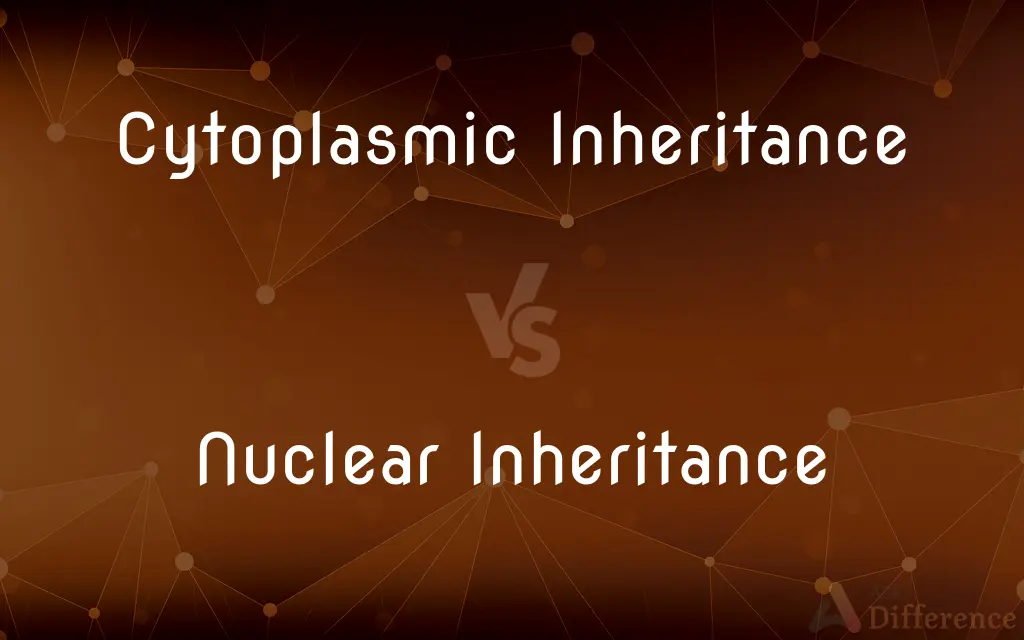Cytoplasmic Inheritance vs. Nuclear Inheritance — What's the Difference?
By Tayyaba Rehman — Published on November 1, 2023
Cytoplasmic Inheritance involves genes from organelles like mitochondria, while Nuclear Inheritance involves genes within the cell nucleus. Both determine organismal traits but involve different genomic locations.

Difference Between Cytoplasmic Inheritance and Nuclear Inheritance
Table of Contents
ADVERTISEMENT
Key Differences
In the study of genetics, Cytoplasmic Inheritance and Nuclear Inheritance stand out as two distinct mechanisms by which traits are passed from one generation to the next. Cytoplasmic Inheritance refers to the transfer of genes that are located in the cytoplasm of the cell, specifically within organelles like mitochondria and chloroplasts. The intriguing facet of Cytoplasmic Inheritance is its non-Mendelian nature, in which traits are typically inherited solely from one parent, usually the mother, disregarding the nuclear genetic information.
On the contrary, Nuclear Inheritance is what is often conventionally referred to when discussing heredity. It involves the transmission of genes that are housed within the cell nucleus. This mechanism follows Mendelian principles, where alleles from both parents, situated on chromosomes within the nucleus, combine and determine the traits of the offspring. Nuclear Inheritance, therefore, necessitates the interaction and assortment of paternal and maternal alleles.
While Cytoplasmic Inheritance is observed to be uniparental (usually maternal) in most species, Nuclear Inheritance is biparental, illustrating a stark contrast in their respective modes of genetic transmission. Additionally, the genes involved in Cytoplasmic Inheritance are often circular, akin to bacterial genomes, whereas Nuclear Inheritance deals with linear chromosomes, which undergo processes like recombination, offering a diversified genetic outlook.
Interestingly, Cytoplasmic Inheritance and Nuclear Inheritance can impact an organism in conjunction, revealing a comprehensive picture of an organism’s genotype. While the former imparts unique traits, often linked to metabolic processes due to the functional nature of mitochondria and chloroplasts, the latter provides the bulk of genetic information, dictating numerous physical, physiological, and biochemical traits of an organism.
One should also be aware that, despite their respective relevance, Nuclear Inheritance is more universally applicable and prevalent, owing to its involvement in the transmission of the majority of an organism’s traits. However, Cytoplasmic Inheritance introduces an additional layer to understanding genetics, revealing that not all heritable information is confined to the nucleus, and contributes to the myriad of ways through which an organism’s genetic material orchestrates its myriad traits.
ADVERTISEMENT
Comparison Chart
Location of Genes
Cytoplasmic organelles (e.g., mitochondria)
Cell nucleus
Type of Inheritance
Typically uniparental (often maternal)
Biparental
Genomic Structure
Circular DNA
Linear chromosomes
Adherence to Mendelian Principles
No
Yes
Role in Trait Determination
Often metabolic/reproductive roles
Broadly influences numerous traits
Compare with Definitions
Cytoplasmic Inheritance
Can dictate specific metabolic traits.
In plants, Cytoplasmic Inheritance can influence certain photosynthetic abilities.
Nuclear Inheritance
Governs a wide array of organismal traits.
From skin type to enzyme function, Nuclear Inheritance is widely influential.
Cytoplasmic Inheritance
Pertains to organelle-specific genes.
Cytoplasmic Inheritance is vital for certain mitochondrial functions.
Nuclear Inheritance
Concerns genes located within the nucleus.
Traits like eye color are determined through Nuclear Inheritance.
Cytoplasmic Inheritance
Involves transmission of genes outside the nucleus.
Cytoplasmic Inheritance explains the maternal lineage of mitochondrial DNA.
Nuclear Inheritance
Engages in biparental transmission of traits.
Children receive genetic material via Nuclear Inheritance from both parents.
Cytoplasmic Inheritance
Is non-Mendelian in nature.
Traits acquired via Cytoplasmic Inheritance don’t follow regular dominance and recessiveness patterns.
Nuclear Inheritance
Involves linear chromosomal DNA.
Nuclear Inheritance encompasses genes on the linear chromosomes of parents.
Cytoplasmic Inheritance
Typically adheres to a uniparental pattern.
Cytoplasmic Inheritance is often evident through maternal gene transmission.
Nuclear Inheritance
Follows Mendelian genetic principles.
Nuclear Inheritance dictates a predictable pattern of allele dominance.
Common Curiosities
Which parent is typically involved in Nuclear Inheritance?
Both parents contribute equally.
Is the paternal involvement equal in Cytoplasmic Inheritance?
No, it's usually maternal, with little or no paternal contribution.
Which traits are majorly determined by Nuclear Inheritance?
Numerous traits, including most physical and physiological ones.
Does Cytoplasmic Inheritance involve nuclear DNA?
No, it involves DNA from organelles like mitochondria.
What is the genetic medium for Cytoplasmic Inheritance?
Organelle DNA, like mitochondrial DNA.
Can Cytoplasmic Inheritance influence offspring phenotypes?
Yes, it can especially impact metabolic processes.
Is Cytoplasmic Inheritance influenced by Mendelian principles?
No, it usually does not follow Mendelian patterns.
Does Nuclear Inheritance influence cellular energy production?
Indirectly, through encoding enzymes and proteins involved in metabolism.
What is the role of Nuclear Inheritance in evolutionary biology?
It provides a mechanism for genetic variability and evolutionary processes.
Do Nuclear Inheritance genes exist in a circular format?
No, they are typically linear chromosomes.
How do alleles assort in Nuclear Inheritance?
They follow Mendelian assortative patterns.
How is genetic variability achieved in Nuclear Inheritance?
Through mechanisms like crossover and mutation.
Are diseases associated with Cytoplasmic Inheritance?
Yes, certain conditions, like mitochondrial diseases, are related to it.
Can traits governed by Cytoplasmic Inheritance be traced through paternal lineage?
Typically no, it's usually traced through the maternal lineage.
Can Cytoplasmic Inheritance affect cellular respiration?
Yes, due to the involvement of mitochondrial genes.
Share Your Discovery

Previous Comparison
Peptides vs. Peptones
Next Comparison
Linux File System vs. Windows File SystemAuthor Spotlight
Written by
Tayyaba RehmanTayyaba Rehman is a distinguished writer, currently serving as a primary contributor to askdifference.com. As a researcher in semantics and etymology, Tayyaba's passion for the complexity of languages and their distinctions has found a perfect home on the platform. Tayyaba delves into the intricacies of language, distinguishing between commonly confused words and phrases, thereby providing clarity for readers worldwide.












































